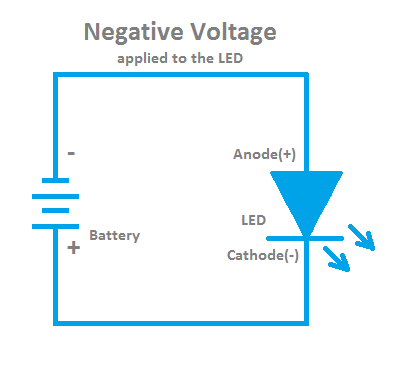Positive Voltage VS Negative Voltage | Examples, Use, Source
What is Positive Voltage?
When a voltage is more positive compared to the ground point then it is called Positive voltage. In other words, we can say the voltage that causes to flow of the current towards the ground is called positive voltage.
Actually, a voltage is divided into positive and negative according to its polarity with a load circuit. For example, if the positive terminal of the battery is connected to the positive terminal of the load circuit and the negative terminal of the battery is connected to the negative terminal of the load circuit then it can be called that a positive voltage is applied to the circuit. And we know that the negative terminal of any circuit is generally connected to the ground or referred to as a ground point. So in this case, the current will flow toward the ground due to the applied positive voltage.
If we described the concept of positive voltage with respect to a fixed higher potential terminal, then it will be seen that due to the positive voltage the current flow from the higher potential to the lower potential.
A conventional battery, DC power source, and Rectifier circuits are the sources of positive voltage.
Here, you can see the positive terminal of the battery is connected to the positive terminal of the LED and the negative terminal of the battery is connected to the negative terminal of the LED. So we can say here a forward voltage positive voltage is applied across the LED.
Positive Voltage Example
Some common examples of positive voltage are,
- Voltage Across a Glowing LED
- Voltage Across a DC motor that rotates in a forward direction
- A battery charger applies a positive voltage to charge a battery
Uses of Positive Voltage Source
Positive voltage is used for conventional and standard electrical operations. In fact, all the domestic and commercial lighting circuits, and other load circuits are operated with a positive voltage source. Although, the AC power supply continuously changes its polarity but we can assume the voltage of the phase with respect to the neutral or ground is a positive voltage that causes to flow current from the phase to neutral.
What is Negative Voltage?
When a voltage is more negative with respect to the ground point is called a Negative Voltage. In other words, we can say the voltage that causes to flow the current to backward from the ground point is known as a negative voltage.
For example, if the negative terminal of a better is connected to the positive terminal of the load circuit and the positive terminal of that battery is connected to the negative terminal of that load circuit, it can be called that a negative voltage is applied to the load circuit. So, the current will flow from the ground point towards the positive terminal.
OpAamp Circuits, Bipolar DC Power supplies are the sources of negative voltage.
Here, you can see the negative terminal of the battery is connected to the positive terminal of the LED and the positive terminal of the battery is connected to the negative terminal of the LED. So we can say here a reverse voltage or negative voltage is applied across the LED.
Negative Voltage Examples
Some common examples of negative voltage are,
- Reverse biasing of transistors
- The voltage across the DC motor that rotates in the reverse direction
- Inverting Circuit using Operational Amplifier
Uses of Negative Voltage
The negative voltage is used for some applications such as,
- To rotate the DC motor in the reverse direction
- Dual operation of operational amplifiers
- Transistor Biasing
Difference between Positive Voltage and Negative Voltage
| Positive Voltage | Negative Voltage |
| Voltage is positive with respect to the ground point | Voltage is negative with respect to the ground point |
| Cause to flow current towards the ground | Cause to flow current backward from the ground |
| The positive terminal of the power source is connected to the positive terminal of the load circuit and the negative terminal of the power source is connected to the negative terminal of the load circuit | The positive terminal of the power source is connected to the Negative terminal of the load circuit and the negative terminal of the power source is connected to the positive terminal of the load circuit |
| Examples: Rectifier Circuit, Battery | Examples: OpAmp, Bipolar Supply, Transistor Biasing |
Read Also:


